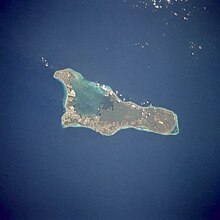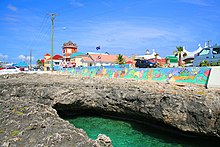
The Cayman Islands (/ˈkeɪmən/ or /keɪˈmæn/) is an autonomous British Overseas Territory in the western Caribbean Sea. The 264-square-kilometre (102-square-mile) territory comprises the three islands of Grand Cayman, Cayman Brac and Little Cayman, which are located to the south of Cuba and northeast of Honduras, between Jamaica and the Yucatán Peninsula. The total population of the three islands is approximately 60,765.[7] The capital city is George Town, situated on Grand Cayman.
The Cayman Islands is considered to be part of the geographic Western Caribbean Zone as well as the Greater Antilles. The territory is often considered a major world offshore financial haven for international businesses and many wealthy individuals
The Cayman Islands remained largely uninhabited until the 17th century. While there is no archaeological evidence for an indigenous people on the islands, a variety of settlers from various backgrounds made their home on the islands, including pirates, shipwrecked sailors, and deserters from Oliver Cromwell's army in Jamaica.[9]
The first recorded permanent inhabitant of the Cayman Islands, Isaac Bodden, was born on Grand Cayman around 1661. He was the grandson of the original settler named Bodden who was probably one of Oliver Cromwell's soldiers at the taking of Jamaica in 1655.[10]
England took formal control of the Cayman Islands, along with Jamaica, as a result of the Treaty of Madrid of 1670. Following several unsuccessful attempts at settlement, a permanent English-speaking population in the islands dates from the 1730s. With settlement, after the first royal land grant by the Governor of Jamaica in 1734, came the perceived need for slaves.[11]Many were brought to the islands from Africa; this is evident today with the majority of native Caymanians being of African and English descent. The results of the first census taken in the islands in 1802 showed the population on Grand Cayman to be 933 with 545 of those inhabitants being enslaved. Slavery was abolished in the Cayman Islands in 1833. At the time of abolition, there were over 950 Blacks of African ancestry enslaved by 116 white families of English ancestry.[12]
The islands continued to be governed as part of the Colony of Jamaica until 1962, when they became a separate Crown colony while Jamaica became an independent Commonwealth realm.[13]
On 8 February 1794, the Caymanians rescued the crews of a group of ten merchant ships, including HMS Convert, an incident that has since become known as the Wreck of the Ten Sail. The ships had struck a reef and run aground during rough seas.[14] Legend has it that King George III rewarded the island with a promise never to introduce taxes as compensation for their generosity, as one of the ships carried a member of the King's own family. While this remains a popular legend, the story is not true.[15]
The Cayman Islands historically has been a tax-exempt destination. The government of the Cayman Islands has always relied on indirect and not direct taxes. The territory has never levied income tax, capital gains tax, or any wealth tax, making them a popular tax haven.[16]
On 11 September 2004 the island of Grand Cayman, which lies largely unprotected at sea level, was hit by Hurricane Ivan, creating an 8-ft (2.4 m) storm surge which flooded many areas of Grand Cayman. An estimated 83% of the dwellings on the island were damaged including 4% requiring complete reconstruction. A reported 70% of all dwellings suffered severe damage from flooding or wind. Another 26% sustained minor damage from partial roof removal, low levels of flooding, or impact with floating or wind driven hurricane debris.[17]Power, water and communications were disrupted for months in some areas as Ivan was the worst hurricane to hit the islands in 86 years.[18]Grand Cayman began a major rebuilding process and within two years its infrastructure was nearly returned to pre-hurricane status. Due to the tropical location of the islands, more hurricanes or tropical systems have affected the Cayman Islands than any other region in the Atlantic basin; it has been brushed or directly hit, on average, every 2.23 years.[19]
Geography[edit]
The islands are in the western Caribbean Sea and are the peaks of a massive underwater ridge, known as the Cayman Ridge (or Cayman Rise). This ridge flanks the Cayman Trough, 6,000 m (20,000 ft) deep[20] which lies 6 km (3.7 mi) to the south.[21] The islands lie in the northwest of the Caribbean Sea, east of Quintana Roo, Mexico and Yucatán State, Mexico, northeast of Costa Rica, north of Panama, south of Cuba and west of Jamaica. They are situated about 700 km (430 mi) south of Miami,[22] 750 km (470 mi) east of Mexico,[23]366 km (227 mi) south of Cuba,[24] and about 500 km (310 mi) northwest of Jamaica.[25] Grand Cayman is by far the largest, with an area of 197 km2 (76 sq mi).[26] Grand Cayman's two "sister islands", Cayman Brac and Little Cayman, are about 120 km (75 mi) east north-east of Grand Cayman and have areas of 38 and 28.5 km2 (14.7 and 11.0 sq mi)[27] respectively.
All three islands were formed by large coral heads covering submerged ice age peaks of western extensions of the Cuban Sierra Maestra range and are mostly flat. One notable exception to this is The Bluff on Cayman Brac's eastern part, which rises to 43 m (141 ft) above sea level, the highest point on the islands.[28]
Terrain is mostly a low-lying limestone base surrounded by coral reefs.
Fauna[edit]
The mammalian species in the Cayman Islands include the introduced Central American agouti[29] and eight species of bats. At least three now extinct native rodent species were present up until the discovery of the islands by Europeans. Marine life around the island of the Grand Cayman includes tarpon, silversides (Atheriniformes), French angelfish (Pomacanthus paru), and giant barrel sponges. A number of cetaceans are found in offshore waters. These species include the goose-beaked whale (Ziphius cavirostris), Blainville's beaked whale (Mesoplodon densirostris) and sperm whale (Physeter macrocephalus).
Cayman avian fauna includes two endemic subspecies of Amazona parrots: Amazona leucocephala hesterna or Cuban amazon, presently restricted to the island of Cayman Brac, but formerly also on Little Cayman, and Amazona leucocephala caymanensis or Grand Cayman parrot, which is native to the Cayman Islands, forested areas of Cuba, and the Isla de la Juventud. Little Cayman and Cayman Brac are also home to red-footed and brown boobies.[30][31] Although the barn owl (Tyto alba) occurs in all three of the islands but they are not commonplace. The Cayman Islands also possess five endemic subspecies of butterflies on the islands.[32] These butterfly breeds can be viewed at the Queen Elizabeth II Botanic Park on the Grand Cayman.
Among other notable fauna at the Queen Elizabeth II Botanic Park is the critically threatened blue iguana which is also known as the Grand Cayman iguana (Cyclura lewisi). The blue iguana is endemic to the Grand Cayman[33] particularly because of rocky, sunlit, open areas near the island's shores that are advantageous for the laying of eggs. Nevertheless, habitat destruction and invasive mammalian predators remain primary reasons that blue iguana hatchlings do not survive naturally.[34]
The Cuban crocodile (Crocodylus rhombifer) once inhabited the islands;[35] and the American crocodile (C. acutus) is thought to be repopulating Grand Cayman. The name "Cayman" is derived from a Carib word for various crocodilians.[36]








No comments:
Post a Comment